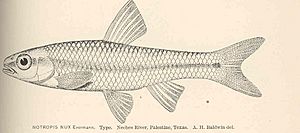Weed shiner facts for kids
The weed shiner (Notropis texanus) is a small, freshwater fish found in North America. It belongs to the minnow family, called Cyprinidae. Before 1958, this fish was known by a different name, Notropis roseus.
Quick facts for kids Weed shiner |
|
|---|---|
 |
|
| Conservation status | |
| Scientific classification | |
| Synonyms | |
|
Contents
What Does the Weed Shiner Look Like?
The weed shiner is a medium-sized minnow. It has a wide, dark stripe along its side. There is also a dark spot at the base of its tail fin. The back part of its anal fin often has dark coloring.
This fish has a body that is a bit flat on the sides. Its mouth is fairly large and points forward or slightly upward. It has a gently rounded snout. The size of its eye is about the same as its snout length.
The weed shiner's back is usually olive-yellow with a shiny silver layer. Its scales have dark edges, which makes it look a bit like a checkerboard. Its belly is white with silver hints. These fish have 6 to 8 gill rakers, which help them filter food. They also have 8 rays in their dorsal fin, 7 in their anal fin, 13 to 14 in their pectoral fins, and 8 in their pelvic fins.
What Do Weed Shiners Eat?
Weed shiners eat during the day. They are most active right after sunrise or in the middle of the afternoon.
During the wet season, their diet is mostly made up of tiny bits of dead plants and animals, called organic detritus. This makes up about 81% of what they eat.
During other times, their diet changes. They eat:
- Animals found on the water's surface (about 20% of their diet)
- Prey found in the middle of the water (about 5%)
- Animals that live at the bottom (about 39%)
- Organic detritus (about 35%)
Where Do Weed Shiners Live?
Weed shiners usually live in the bottom third of the water. They prefer small to medium-sized streams with slow to medium water flow.
You can also find them in places made by people, like ponds and reservoirs. They live in natural oxbow lakes too. Even though their name includes "weed," these fish live in waterways with and without lots of plants.
Reproduction and Life Cycle
Weed shiners lay their eggs from March through September. Sometimes they even lay eggs in early October. They do this when the water temperature is between 14 and 29 degrees Celsius.
Female weed shiners lay several groups of eggs during the breeding season. Because of this, it's hard to know exactly how many eggs one female lays in a year.
Scientists don't know much yet about how young weed shiners develop after hatching. However, they do know that these fish grow very quickly when they are young. After just one year, they reach about 60% of their full adult size. Most weed shiners live for about three years, but some can live up to four years.
Where Are Weed Shiners Found?
The weed shiner lives in the Mississippi River Basin. This area stretches from Minnesota and Wisconsin all the way down to the Gulf of Mexico.
They are also found throughout the Gulf of Mexico drainage. This includes rivers from the Suwannee River in Florida and Georgia to the Nueces River in Texas. They are more common south of where the Ohio and Tennessee Rivers meet. Weed shiners have also been seen in the Red River of the North drainage in Minnesota. They have even been reported in areas around Lake Michigan and Lake Huron.
What Does Their Name Mean?
The name Notropis means "keeled back." The word texanus refers to where the first weed shiner was found and described, which was Salado Creek in Texas.
See also
 In Spanish: Notropis texanus para niños
In Spanish: Notropis texanus para niños


